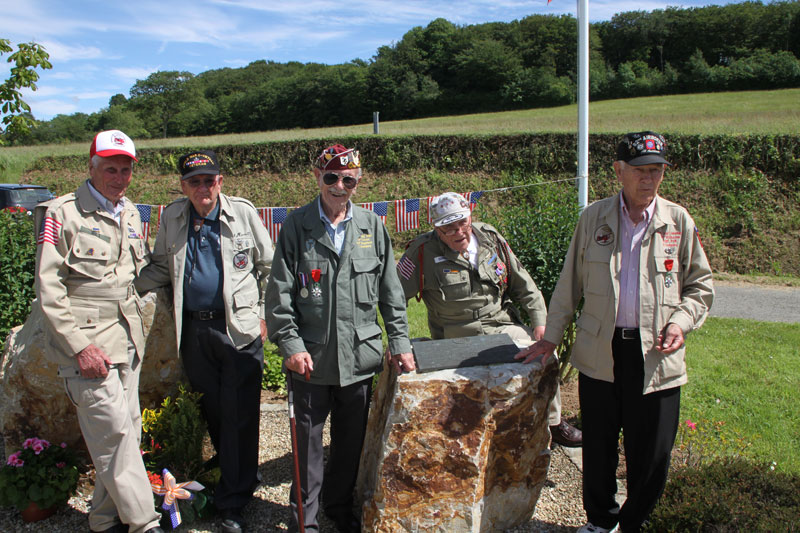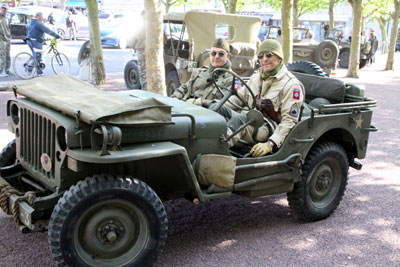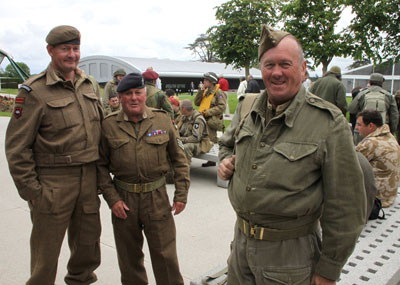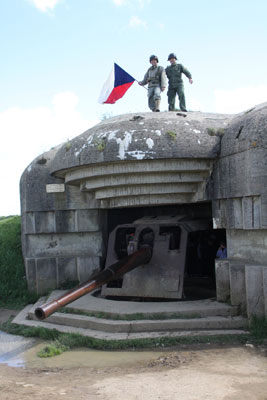Remembering D-Day: A moving visit to Normandy, France
This article appears on page 6 of the March 2015 issue.
Calling all WWII buffs! Normandy is a great travel venue at any time of the year, but this region of France is especially attractive during the anniversary week of D-Day.
The Normans celebrate “le Débarquement” every year, and they celebrate in a big way. From June 5 to June 9, especially, you will encounter parades; fireworks; monument dedications; 1940s jazz concerts and “liberation balls”; ceremonies; commemorative church services; reenactments; vintage military vehicles of all sizes and shapes; military memorabilia markets; reconstructions of military encampments; C-47 parachute drops, and, the greatest draw of all, D-Day veterans returning to pay their respects to their fallen comrades.
A special year
My husband, David, and I were fortunate to be in Normandy in June 2014 for the 70th anniversary of D-Day. We stayed just outside of Sainte-Mère-Église… and was that town hopping!
When we arrived on June 1, hoping to beat the hordes, it was very crowded. Then it got worse. All of France, and a good part of the EU, the UK and the US, descended on Normandy that week.
The good part was that there were many interesting and exciting things to do and see; the bad part was getting to and from these interesting and exciting things to do and see. Thank goodness we had a good map; GPS doesn’t work well when there are traffic jams or barricaded roads.
Unfortunately, one of the casualties of our busy D-Day visit was exploring the area with the Open Sky Museum, a “visio-guide” (a GPS-equipped self-tour device) that leads travelers on a 50-kilometer tour to venues around Sainte-Mère-Église to help them understand the events of June 1944, with testimonies, archives and videos. The equipment rents for €8 ($9) per day, with a €250 deposit, and is available from the Sainte-Mère-Église tourism office. We’ve marked that on our “to do” list for next time.
We were amazed at the number of reenactors who crowded the streets and campgrounds. It seems that everybody and his brother in Europe owns a ’40s-era American jeep, half-track, ambulance, troop truck, tank, motorcycle… you name it. All the flotsam and jetsam that was left behind after the war was there to see in all its well-maintained glory.
The reenactors added a lot of color to the event. I wish now that we had taken the time to wander through one of the military camps to see how they were roughing it.
We saw soldiers of all nationalities wearing American WWII uniforms, from privates to a General Patton! Several men, dressed as Pathfinders, even had mohawk haircuts.
Women wearing ’40s-era dresses or WAC uniforms rolled up their hair à la the Andrews Sisters, and big band music played everywhere. We wondered if the presence of the reenactors detracted from the many bona fide soldiers and veterans, but the veterans, themselves, seemed to enjoy it immensely. (We heard more than one reenactor marveling that WWII veterans wanted to have their photos taken with them!)
Amongst friends
On this trip we were thrilled to be accompanying two veterans: our old friend from Johnstown, Ohio, Don “Jake” Jakeway (508th Parachute Infantry Regiment, 82nd Airborne), who parachuted into the area around Sainte-Mère-Église on D-Day and into the Netherlands during Operation Market Garden and was seriously wounded in the Battle of the Bulge, and our new friend, Herman “Zerg” Zerger (141st Regiment, 36th Infantry Division) from Woodsfield, Ohio, who fought in Italy, made his way into France from the south and was taken prisoner of war during the Battle of the Bulge.
We met many other veterans, including a German POW. Sadly, one of our favorites, Jack Schlegel, whom we met at the home of Norman friends, died the day after returning home. That certainly brought home the message that we are losing more members of our Greatest Generation every day.
We heard that 3,000 WWII veterans made it to France for the 70th-anniversary festivities; few will be able to make the 75th.
We hope that veterans and other interested travelers won’t wait for the 75th anniversary. The Normans will welcome them any year, at any time of year, but that is especially true during D-Day celebrations.
We found the people of Normandy to be very pro-American. A complete stranger with whom we chatted while waiting in line to buy fresh-off-the-grill sausage sandwiches had paid for ours before we got to the counter. He said we could buy him a sandwich when he comes to America!
Honoring heroes
Just before we left home, we learned about a local tie to Normandy. A neighbor’s brother-in-law, Robert Wright, a medic in the 101st Airborne, also parachuted into Normandy on D-Day. Robert and a fellow medic, Kenneth Moore, set up a first-aid station in a 12th-century church in the village of Angoville-au-Plain, where for three days they treated 80 wounded soldiers, regardless of which side they were on, as well as a local child.
The village changed hands several times, but the Germans left them alone, knowing that German soldiers were also being cared for.
Blood stains are still visible on the pews, and two stained-glass windows pay tribute to the medics. There is also a monument outside the church dedicated to them.
Robert Wright, Jr., took his father’s ashes to the church in 2014; Robert Wright, Sr., died Dec. 21, 2013.
We arrived on June 5, and from then on our activities were nonstop. We picnicked with veterans and active-duty soldiers in Chef-du-Pont prior to a ceremony honoring Jake’s regiment, the 508th PIR, then attended the dedication of the new wing of the Airborne Museum in Sainte-Mère-Église.
I was delighted to get my picture taken with guest speaker Michael Reagan, son of Ronald Reagan and Jane Wyman. The Reagan Legacy Foundation is a big donor to the Airborne Museum.
A complicated journey
The official French/American D-Day ceremony took place at the Normandy American Cemetery the following day, June 6. The experience was as difficult as it was exciting.
The actual ceremony wasn’t long, but, including travel time, it was 11 hours from the time we left home to the time we got back. Because all of the roads were closed that day for security, we had to drive to a meeting point, show our passes, travel in small groups escorted by gendarmes on motorcycles, park along the side of a narrow road in the middle of nowhere, transfer to a bus that didn’t move for an hour… . You get the picture.
By the time we arrived at the cemetery, we all made a beeline to the toilettes. However, all of the facilities inside the security area were locked, except for one lone handicapped stall.
We thought it was a nice gesture to supply each of us with two energy bars and two bottles of water for our wait in the sun, but where were we to recycle that water?
Our bus had deposited us at the rear entrance to the cemetery, so we did not know that there were at least 30 porta-potties outside the secured area. (Even if we had known, I am not sure we would have wanted to brave the security gauntlet a second time.)
Remembrances
The following day was our favorite. We got to follow Jake’s footsteps from his landing zone to sites where he fought with his unit (once he caught up to them). For the first three days, Jake was on his own, hiding from Germans and searching for any American troops. Then he joined a unit of the 101st Airborne for a week until he was reunited with his unit on D+10.
Following in his footsteps was amazing. Jake’s stories seemed so much more real in situ. He showed us the tree that he thinks he landed in, then waved in the general direction of the fresh “cow pie” he slid into after jumping a hedgerow to elude advancing footsteps.
Later came somber reflections. He pointed to a distant hedgerow and said, “That’s where I headed when we realized the field was mined.”
Then he indicated the tree line where the Hitler Youth were waiting to pick them off one by one.
Jake lost seven friends at Hill 95, our final stop of the day.
Three other veterans from the 508th were with us that day, and they also spoke at the battle sites. What an honor it was to view history through the eyes of the history-makers.
The Sunday after D-Day we watched more than 600 international paratroopers land in a field next to the bridge at La Fière, where many paratroopers landed on the night of June 5-6, 1944. This bridge was one of only two over the flooded Merderet River, so taking it and holding it were primary missions of the 82nd.
Parachute jumps are now scheduled every year for the D-Day festivities, but they are canceled when, as in 1944, Mother Nature does not provide conditions conducive to successful jumps.
We were lucky; the day was sunny, the sky was blue, and there was little wind. It was a perfect day for a parachute jump.
A final evening
Our last evening was a warm, wonderful, fitting farewell to this journey back in time. We dined that night at the home of Henri-Jean and Yvette Renaud with our two veterans and our good Norman friends. Henri-Jean Renaud is the vice-president of the Airborne Museum and the son of Sainte-Mère-Église’s wartime mayor, Alexandre Renaud, and his wife, Simone.
A 2010 documentary, “Mother of Normandy,” tells the story of Simone Renaud, who, after seeing the loss of life on D-Day, spent the rest of her life doing her best to heal American families who lost their sons and husbands in Normandy. She took care of many graves at the three temporary cemeteries in Sainte-Mère-Église, decorating them and sending photos of them to the families.
Simone corresponded with American families for 44 years, often hosting them in her home during their visits to Normandy. Her three sons have kept up the correspondence and the hosting since her death in 1988.
Son Henri-Jean and his wife hosted our veterans, Jake and Zerg, during our D-Day stay. Spending our last moments in Normandy in their company was a lovely way to end an emotion-filled historical adventure.
Seven tips for your trip
If you’re planning a visit to Normandy, I would keep the following in mind.
1. Visit during an off year. You will reap the benefits without all the drawbacks.
2. Take a ’40s outfit… and wear it.
3. Watch “The Longest Day” one more time. Sure, it’s Hollywood and not historically correct on every point, but it will enrich your knowledge of Sainte-Mère-Église, the airborne troops, the scaling of the Pointe du Hoc and the landings on all five Normandy beaches (Utah, Omaha, Gold, Juno and Sword) as well as the German point of view.
“Saving Private Ryan” may be more realistic, as far as the Omaha Beach landing is concerned, but that landing is the only one portrayed.
4. Get a good map. We used a spiral-bound “Michelin France Atlas Routier” (road atlas) that we purchased at a rest stop (aire) on the Normandy Autoroute, the A13. Its scale of 1:200,000 helped a lot when we were trying to circumnavigate bottlenecks.
5. Check out the Sainte-Mère-Église tourism office website (www.sainte-mere-eglise.info) and Trip
Advisor.com to see what the town has to offer.
The Airborne Museum is one of the finest in the world, and it has a terrific gift shop; be sure to pick up a cricket (a device used by paratroopers to signal to each other).
The newly dedicated wing’s sensation-filled journey makes you feel like you are parachuting into Sainte-Mère-Église on the night of June 5-6.
In addition to admiring the exterior of the village church with its mannequin of American partatrooper John Steele hanging from the spire, go inside to see the two magnificent stained-glass windows with their parachute motif.
The Town Hall has the kilometer zero marker, signifying that Sainte-Mère-Église was the first town liberated in France on D-Day. More than 1,000 mileage markers just like it lead all the way across northern France to Bastogne, Belgium, on the Path of Liberty.
The town’s main square, La Place du 6 Juin, and Rue Eisenhower are chock-full of monuments, shops and cafés.
If you, or your kids, begin to tire of WWII sites, the open-air Ferme musée du Cotentin (farm museum) is a good change of pace. So is the cookie factory, Le Biscuit de Sainte-Mère-Église (5 rue de la Division Leclerc). Be sure to sample the parachute-shaped shortbread cookies.
6. Don’t miss the following sites around Sainte-Mère-Église: Utah Beach; Angoville-au-Plain; Dead Man’s Corner Museum; La Fière bridge; the German coastal defenses (batteries) of Azeville and Crisbecq, which formed part of Hitler’s Atlantic Wall; Quinéville’s Mémorial de la Liberté retrouvée; the German cemetery in Orglandes; Chef du Pont, and the nearby Mur des Souvenirs (Wall of Remembrance) in Port-Filiolet.
David and I also enjoyed the Hangar à Dirigeables d’Ecausseville because my father was a WWII blimp pilot. This is one of the very few remaining blimp hangars in Europe.
7. Stay at Château de Brix (see my review on page 54 of the November 2014 issue). Most American visitors to Normandy see only the Calvados region (Omaha Beach, Bayeux and Caen), but the Manche region around Sainte-Mère-Église is an ideal, more central location for visiting much of Normandy.
Utah Beach is next door. To the east, the American Cemetery above Omaha Beach is 27 miles, or 35 minutes, away. Bayeux and its famous tapestry are 33 miles (41 minutes) and Caen is 51 miles (one hour) away.
To the north, Cherbourg can be reached in 35 minutes, to the south, St. Lô in 38, and even Mont St-Michel (to the west) takes less than an hour and a half to reach. Location, location, location!





